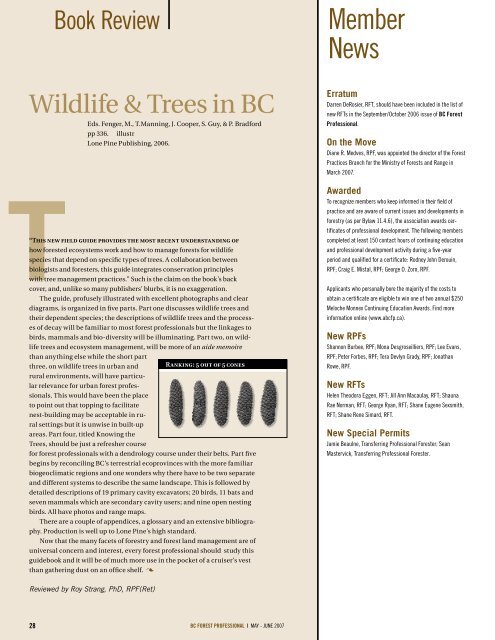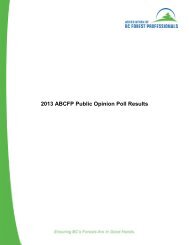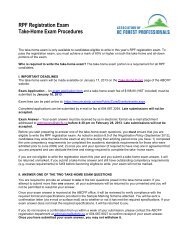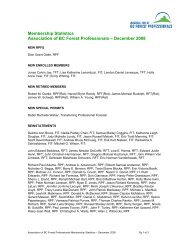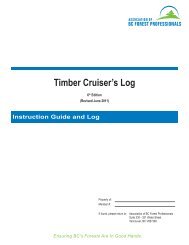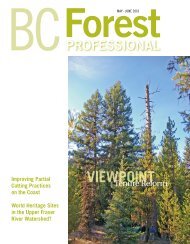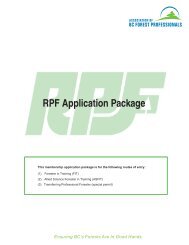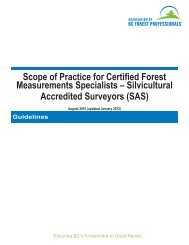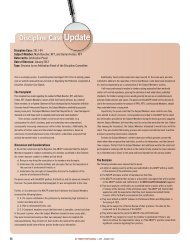T - Association of BC Forest Professionals
T - Association of BC Forest Professionals
T - Association of BC Forest Professionals
You also want an ePaper? Increase the reach of your titles
YUMPU automatically turns print PDFs into web optimized ePapers that Google loves.
Book Review<br />
Wildlife & Trees in <strong>BC</strong><br />
Eds. Fenger, M., T.Manning, J. Cooper, S. Guy, & P. Bradford<br />
pp 336. illustr<br />
Lone Pine Publishing, 2006.<br />
T“This new field guide provides the most recent understanding <strong>of</strong><br />
how forested ecosystems work and how to manage forests for wildlife<br />
species that depend on specific types <strong>of</strong> trees. A collaboration between<br />
biologists and foresters, this guide integrates conservation principles<br />
with tree management practices.” Such is the claim on the book’s back<br />
cover, and, unlike so many publishers’ blurbs, it is no exaggeration.<br />
The guide, pr<strong>of</strong>usely illustrated with excellent photographs and clear<br />
diagrams, is organized in five parts. Part one discusses wildlife trees and<br />
their dependent species; the descriptions <strong>of</strong> wildlife trees and the processes<br />
<strong>of</strong> decay will be familiar to most forest pr<strong>of</strong>essionals but the linkages to<br />
birds, mammals and bio-diversity will be illuminating. Part two, on wildlife<br />
trees and ecosystem management, will be more <strong>of</strong> an aide memoire<br />
than anything else while the short part<br />
three, on wildlife trees in urban and Ranking: 5 out <strong>of</strong> 5 cones<br />
rural environments, will have particular<br />
relevance for urban forest pr<strong>of</strong>essionals.<br />
This would have been the place<br />
to point out that topping to facilitate<br />
nest-building may be acceptable in rural<br />
settings but it is unwise in built-up<br />
areas. Part four, titled Knowing the<br />
Trees, should be just a refresher course<br />
for forest pr<strong>of</strong>essionals with a dendrology course under their belts. Part five<br />
begins by reconciling <strong>BC</strong>’s terrestrial ecoprovinces with the more familiar<br />
biogeoclimatic regions and one wonders why there have to be two separate<br />
and different systems to describe the same landscape. This is followed by<br />
detailed descriptions <strong>of</strong> 19 primary cavity excavators; 20 birds, 11 bats and<br />
seven mammals which are secondary cavity users; and nine open nesting<br />
birds. All have photos and range maps.<br />
There are a couple <strong>of</strong> appendices, a glossary and an extensive bibliography.<br />
Production is well up to Lone Pine’s high standard.<br />
Now that the many facets <strong>of</strong> forestry and forest land management are <strong>of</strong><br />
universal concern and interest, every forest pr<strong>of</strong>essional should study this<br />
guidebook and it will be <strong>of</strong> much more use in the pocket <strong>of</strong> a cruiser’s vest<br />
than gathering dust on an <strong>of</strong>fice shelf. �<br />
Reviewed by Roy Strang, PhD, RPF(Ret)<br />
28 <strong>BC</strong> FOREST PROFESSIONAL | MAY - JUNE 2007<br />
Member<br />
News<br />
Erratum<br />
Darren DeRosier, RFT, should have been included in the list <strong>of</strong><br />
new RFTs in the September/October 2006 issue <strong>of</strong> <strong>BC</strong> <strong>Forest</strong><br />
Pr<strong>of</strong>essional.<br />
On the Move<br />
Diane R. Medves, RPF, was appointed the director <strong>of</strong> the <strong>Forest</strong><br />
Practices Branch for the Ministry <strong>of</strong> <strong>Forest</strong>s and Range in<br />
March 2007.<br />
Awarded<br />
To recognize members who keep informed in their field <strong>of</strong><br />
practice and are aware <strong>of</strong> current issues and developments in<br />
forestry (as per Bylaw 11.4.6), the association awards certificates<br />
<strong>of</strong> pr<strong>of</strong>essional development. The following members<br />
completed at least 150 contact hours <strong>of</strong> continuing education<br />
and pr<strong>of</strong>essional development activity during a five-year<br />
period and qualified for a certificate: Rodney John Derouin,<br />
RPF; Craig E. Mistal, RPF; George O. Zorn, RPF.<br />
Applicants who personally bore the majority <strong>of</strong> the costs to<br />
obtain a certificate are eligible to win one <strong>of</strong> two annual $250<br />
Meloche Monnex Continuing Education Awards. Find more<br />
information online (www.abcfp.ca).<br />
New RPFs<br />
Shannon Burbee, RPF; Mona Desgroseilliers, RPF; Lee Evans,<br />
RPF; Peter Forbes, RPF; Tera Devlyn Grady, RPF; Jonathan<br />
Rowe, RPF.<br />
New RFTs<br />
Helen Theodora Eggen, RFT; Jill Ann Macaulay, RFT; Shauna<br />
Rae Norman, RFT; George Ryan, RFT; Shane Eugene Sexsmith,<br />
RFT; Shane Rene Simard, RFT.<br />
New Special Permits<br />
Jamie Beaulne, Transferring Pr<strong>of</strong>essional <strong>Forest</strong>er; Sean<br />
Mastervick, Transferring Pr<strong>of</strong>essional <strong>Forest</strong>er.


